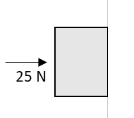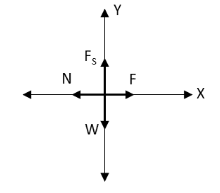
A horizontal force of \[25\,{\text{N}}\] is necessary to just hold a block stationary against a wall. The coefficient of friction between the block and the wall is 0.4. The weight of the block is:

A.\[2.5\,{\text{N}}\]
B.\[20\,{\text{N}}\]
C.\[10\,{\text{N}}\]
D.\[5\,{\text{N}}\]

Answer
448.5k+ views
Hint:Use the expression for Newton’s second law of motion and also use the formula for static frictional force in terms of coefficient of static friction and normal force. Draw the free body diagram of the block. From this free body diagram first calculate the normal force between the wall and the block. Then apply Newton’s second law in vertical direction and calculate the weight of the block using formula for frictional force.
Formulae used:
The expression for Newton’s second law of motion is
\[{F_{net}} = ma\] …… (1)
Here, \[{F_{net}}\] is the net force acting on the object, \[m\] is mass of the object and \[a\] is acceleration of the object.
The static frictional force \[{F_S}\] is given by
\[{F_S} = {\mu _S}N\] …… (2)
Here, \[{\mu _S}\] is coefficient of static friction and \[N\] is the normal force acting on the object.
Complete step by step answer:
We have given that the horizontal force required to hold the block in its position on the wall is \[25\,{\text{N}}\] and the coefficient of static friction between the block and the wall is 0.4.
\[F = 25\,{\text{N}}\]
\[{\mu _S} = 0.4\]
We have asked to calculate the weight of the block. Let us draw the free body diagram of the block.

In the above free body diagram, \[F\] is the horizontal force necessary to hold the block in its position on the wall, \[N\] is the normal force exerted by the wall on the block, \[W\] is the weight of block and \[{F_S}\] is static frictional force between the block and the wall.Let us calculate the normal force exerted by the wall on the block.Apply Newton’s second law of motion to the block in the horizontal direction.
\[F = N\]
Substitute \[25\,{\text{N}}\] for \[F\] in the above equation.
\[N = 25\,{\text{N}}\]
Hence, the normal force exerted by the wall on the block is \[25\,{\text{N}}\].
Let us now calculate the weight of the block.Apply Newton’s second law of motion to the block in the vertical direction.
\[{F_S} = W\]
Substitute \[{\mu _S}N\] for \[{F_S}\] in the above equation.
\[W = {\mu _S}N\]
Substitute \[0.4\] for \[{\mu _S}\] and \[25\,{\text{N}}\] for \[N\] in the above equation.
\[W = \left( {0.4} \right)\left( {25\,{\text{N}}} \right)\]
\[ \therefore W = 10\,{\text{N}}\]
Therefore, the weight of the block is \[10\,{\text{N}}\].
Hence, the correct option is C.
Note:The students may think that we have applied Newton’s second law of motion to the block in the horizontal and vertical component. But we have not used the right hand side terms in the expression for Newton’s second law. The students should keep in mind that the block is stationary on the wall. Hence, the acceleration of the block is zero. Hence, the net force on the block is also zero. So, the right hand side term in the expression for Newton’ second law is zero.
Formulae used:
The expression for Newton’s second law of motion is
\[{F_{net}} = ma\] …… (1)
Here, \[{F_{net}}\] is the net force acting on the object, \[m\] is mass of the object and \[a\] is acceleration of the object.
The static frictional force \[{F_S}\] is given by
\[{F_S} = {\mu _S}N\] …… (2)
Here, \[{\mu _S}\] is coefficient of static friction and \[N\] is the normal force acting on the object.
Complete step by step answer:
We have given that the horizontal force required to hold the block in its position on the wall is \[25\,{\text{N}}\] and the coefficient of static friction between the block and the wall is 0.4.
\[F = 25\,{\text{N}}\]
\[{\mu _S} = 0.4\]
We have asked to calculate the weight of the block. Let us draw the free body diagram of the block.

In the above free body diagram, \[F\] is the horizontal force necessary to hold the block in its position on the wall, \[N\] is the normal force exerted by the wall on the block, \[W\] is the weight of block and \[{F_S}\] is static frictional force between the block and the wall.Let us calculate the normal force exerted by the wall on the block.Apply Newton’s second law of motion to the block in the horizontal direction.
\[F = N\]
Substitute \[25\,{\text{N}}\] for \[F\] in the above equation.
\[N = 25\,{\text{N}}\]
Hence, the normal force exerted by the wall on the block is \[25\,{\text{N}}\].
Let us now calculate the weight of the block.Apply Newton’s second law of motion to the block in the vertical direction.
\[{F_S} = W\]
Substitute \[{\mu _S}N\] for \[{F_S}\] in the above equation.
\[W = {\mu _S}N\]
Substitute \[0.4\] for \[{\mu _S}\] and \[25\,{\text{N}}\] for \[N\] in the above equation.
\[W = \left( {0.4} \right)\left( {25\,{\text{N}}} \right)\]
\[ \therefore W = 10\,{\text{N}}\]
Therefore, the weight of the block is \[10\,{\text{N}}\].
Hence, the correct option is C.
Note:The students may think that we have applied Newton’s second law of motion to the block in the horizontal and vertical component. But we have not used the right hand side terms in the expression for Newton’s second law. The students should keep in mind that the block is stationary on the wall. Hence, the acceleration of the block is zero. Hence, the net force on the block is also zero. So, the right hand side term in the expression for Newton’ second law is zero.
Recently Updated Pages
Master Class 11 English: Engaging Questions & Answers for Success

Master Class 11 Computer Science: Engaging Questions & Answers for Success

Master Class 11 Maths: Engaging Questions & Answers for Success

Master Class 11 Social Science: Engaging Questions & Answers for Success

Master Class 11 Economics: Engaging Questions & Answers for Success

Master Class 11 Business Studies: Engaging Questions & Answers for Success

Trending doubts
10 examples of friction in our daily life

What problem did Carter face when he reached the mummy class 11 english CBSE

One Metric ton is equal to kg A 10000 B 1000 C 100 class 11 physics CBSE

Difference Between Prokaryotic Cells and Eukaryotic Cells

State and prove Bernoullis theorem class 11 physics CBSE

The sequence of spore production in Puccinia wheat class 11 biology CBSE




